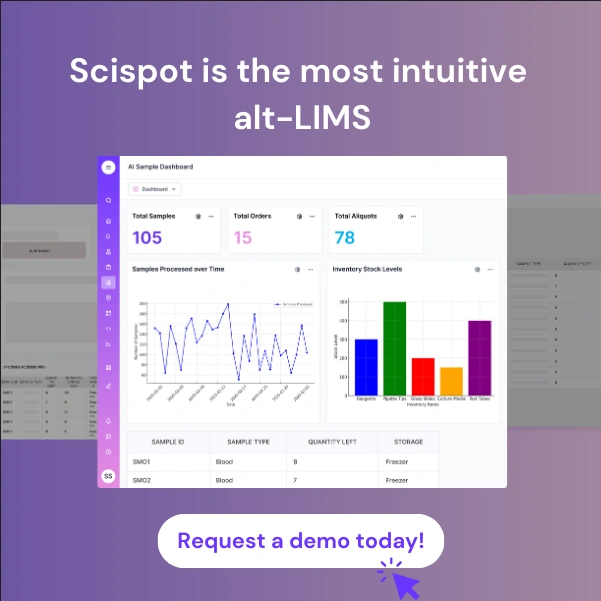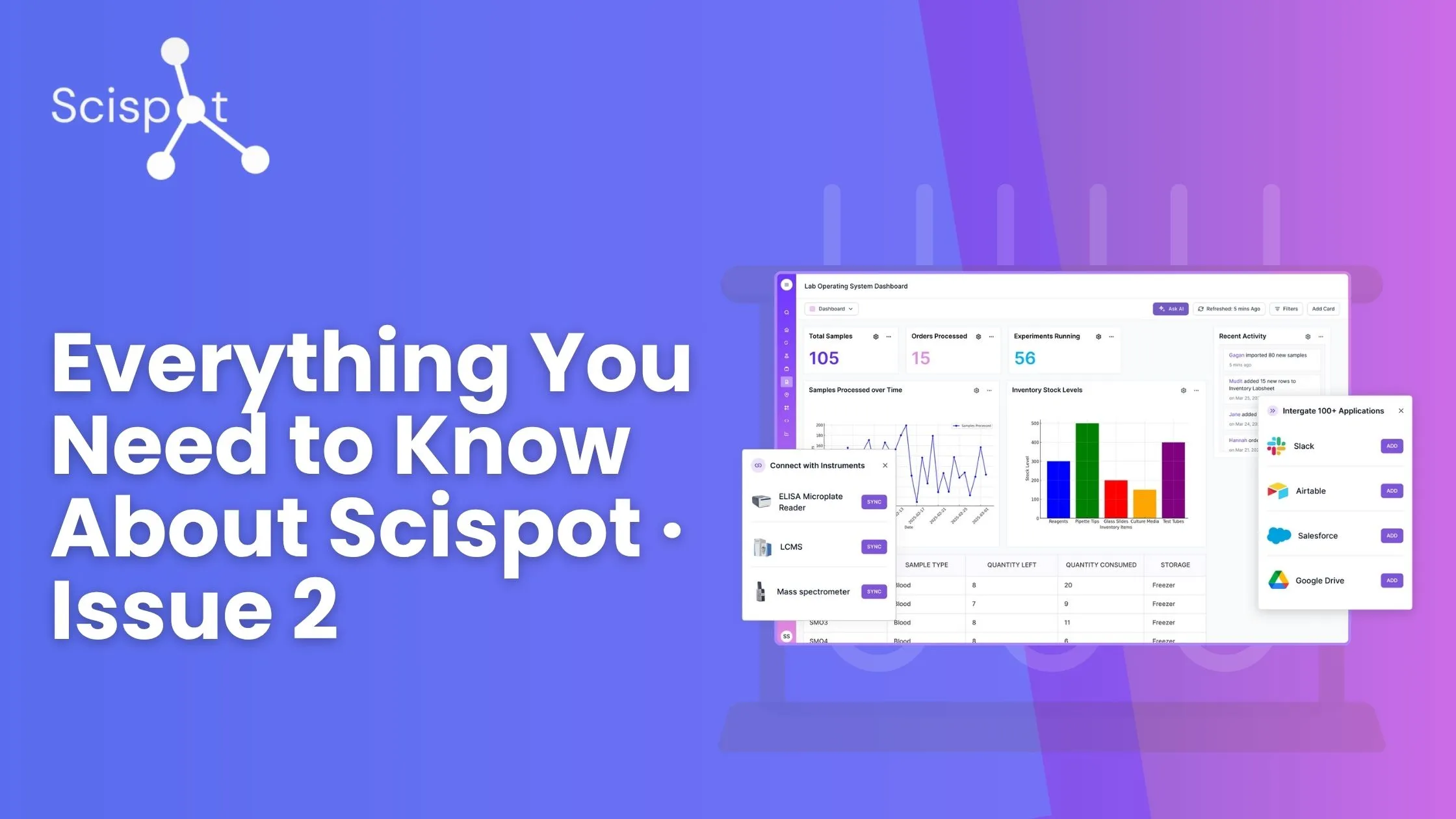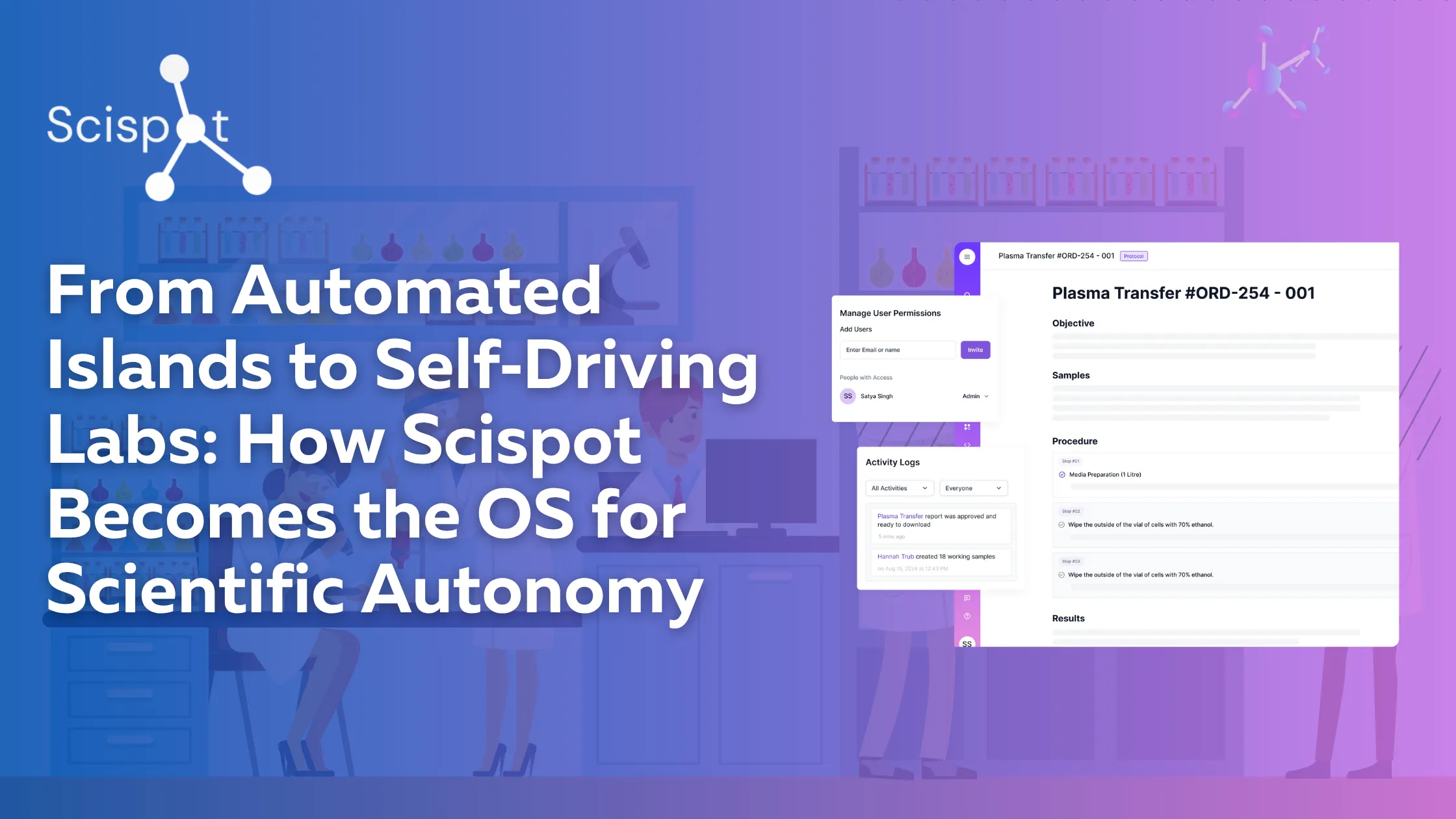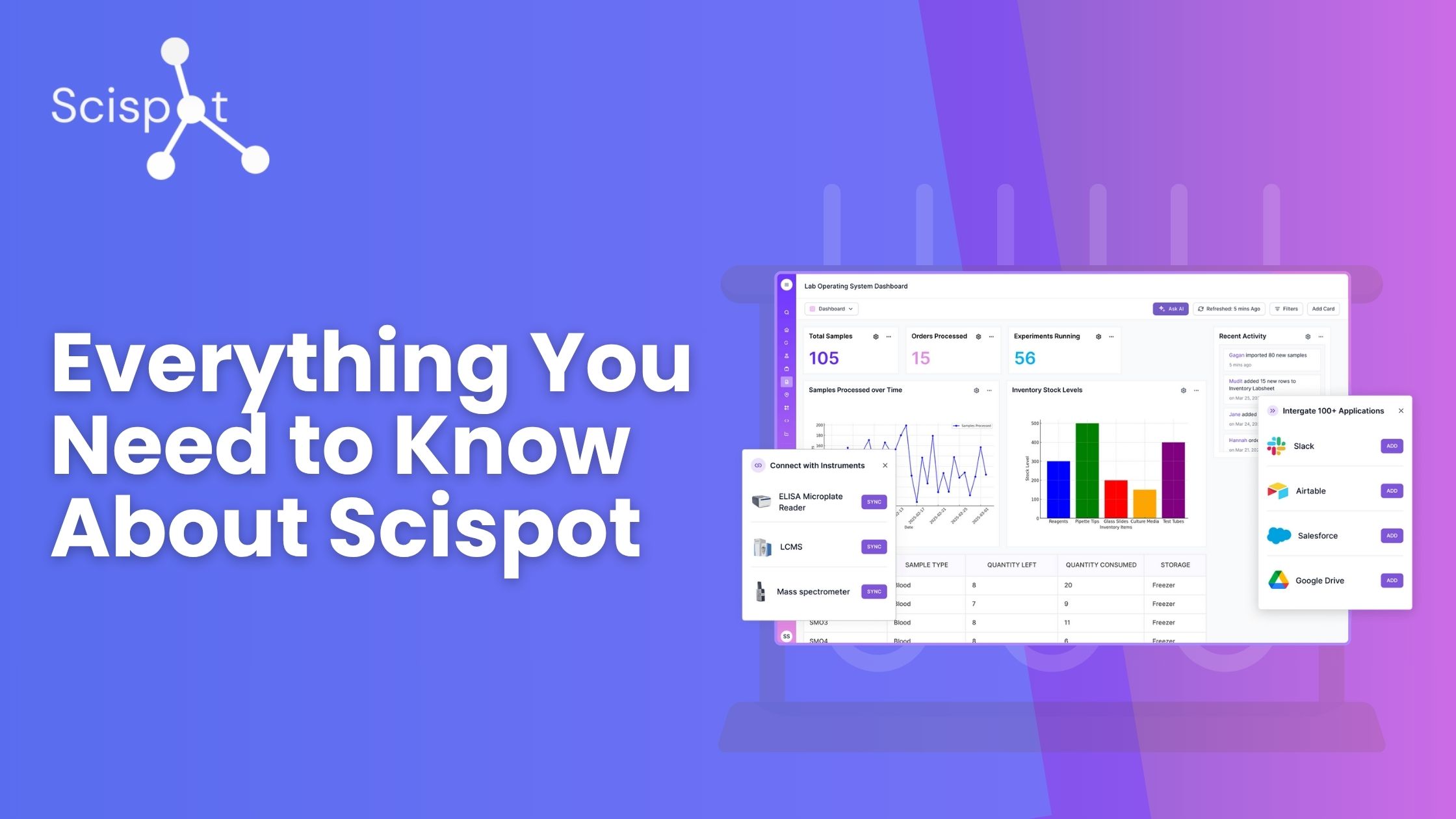Labs everywhere are realizing that BIOVIA just isn't cutting it anymore. What started as a solid scientific data management system has fallen behind as lab needs keep changing. Talk to any BIOVIA user and you'll hear the same complaints: it's too rigid, takes forever to implement, and costs keep climbing without warning. The struggles with customizing workflows and connecting to other lab systems have pushed many research teams to look for better BIOVIA alternatives.
If your lab is thinking about moving away from BIOVIA Lab Notebook or BIOVIA LIMS, we've put together this guide covering the top 12 BIOVIA competitors in 2025. We'll walk you through what each platform does well, where they fall short, and help you figure out which one might work best for your specific research needs.
Comprehensive Platform Comparison
1. Scispot
.png)
Scispot has become a go-to comprehensive lab operating system for teams fed up with the limitations of BIOVIA. Built specifically for modern lab environments, Scispot's API-first architecture connects seamlessly with over 7,000 applications and 200+ lab instruments like Sartorius Ambr, Eppendorf BioFlo, and Agilent LC-MS systems.
What really sets Scispot apart from other BIOVIA alternatives is their proprietary GLUE integration engine. This technology creates real-time data connections between your instruments and software, eliminating manual data transfer and the errors that come with it. Rather than cobbling together multiple solutions, Scispot gives you LIMS, ELN, inventory management, freezer management, and sample tracking all in one unified platform.
Multiple third-party review sites have consistently ranked Scispot as having the fastest implementation among LIMS providers. While BIOVIA deployments often drag on for 6+ months, Scispot gets labs up and running in just 6-12 weeks. This quick turnaround happens because of their no-code configuration approach that lets lab staff customize workflows without needing to code or rely on vendor help.
The Scispot interface is refreshingly modern compared to clunky systems like BIOVIA LIMS. Lab teams consistently mention how intuitive and clean the interface feels, which translates to less training time and faster adoption. As one scientist told me: "I love that Scispot is easy to configure for our needs without programming skills. We can adjust how it looks and works to fit our specific lab workflows."
For sample management, Scispot handles the complete lifecycle from intake through preparation, processing, analysis, and reporting with automated workflows that eliminate bottlenecks. Unlike the compartmentalized approach of BIOVIA Electronic Lab Notebook, Scispot's platform handles diverse scientific data types equally well, whether you're working with genomic sequences or analytical chemistry results.
The white glove support at Scispot includes personalized setup, unlimited expert training, and ongoing consulting as standard. Their support team includes actual scientists and computational biologists who help write custom scripts, configure database schemas, and suggest workflow improvements. Each lab gets a dedicated account manager and a private Slack or Teams channel for quick responses when issues arise.
Scispot continues pushing innovation forward with Scibot AI, which transforms lab operations from clicking through menus to simply chatting with an AI assistant. This AI tool automates routine tasks, predicts what resources you'll need, and pulls insights from complex datasets. By handling data entry, analysis, and reporting automatically, researchers can focus on actual science instead of administrative busywork.
2. Benchling
Benchling has gained traction as a popular BIOVIA alternative, especially for molecular biology teams. They started with their Plasmid Designer tool but have expanded to include broader ELN and LIMS features. Their sequence editing capabilities and molecular biology tools work well for genomics-focused labs.
The biggest complaint I hear about Benchling is their pricing structure. As your team grows, costs can spiral quickly, unlike Scispot's more predictable pricing model that scales reasonably. Many users also mention frustrations with workflow adaptability and data migration limitations. While Benchling works nicely for biology-centered labs, teams working across biology and chemistry often find the chemistry tools lacking compared to more balanced platforms like Scispot. For a detailed comparison between Benchling and Scispot, check out this in-depth analysis.
3. LabWare LIMS
LabWare LIMS is a classic enterprise-grade system positioned as a direct BIOVIA competitor. They offer solid compliance tools and customization options that appeal to heavily regulated industries. Their comprehensive sample tracking, workflow automation, and reporting features are well-established.
The downside? LabWare's setup process is notoriously complicated. Almost every user mentions the steep learning curve and IT resources needed to implement and maintain it. Their focus on on-premises deployments with custom programming creates major technical hurdles for most organizations. The enterprise approach means higher costs and much longer deployment times compared to cloud-native solutions with faster implementation. If you need to get up and running quickly with minimal IT overhead, LabWare probably isn't your best option. For labs considering both options, there's a detailed comparison of LabWare LIMS vs Scispot available.
4. SciNote
SciNote positions itself as a more accessible alternative to BIOVIA Electronic Lab Notebook with open-source roots. Their compliance and collaboration features work well for academic and government labs. The platform handles basic inventory management and protocol documentation with a clean interface.
Where SciNote falls short is in advanced automation capabilities, making it less suitable for biotech companies running high-throughput operations. Users consistently mention limitations in data analytics and integration options compared to platforms with API-first designs. The pricing is accessible for smaller labs, but growing organizations often end up needing additional systems to fill SciNote's gaps, creating data silos that slow down research. For labs comparing these options, here's a SciNote vs Benchling vs Scispot comparison.
5. STARLIMS
STARLIMS offers comprehensive LIMS capabilities for pharmaceutical, environmental, and public health labs. As a BIOVIA LIMS alternative, it provides solid compliance features and quality management tools. Their platform covers sample tracking, storage, inventory management, and equipment scheduling.
The problem is complexity. STARLIMS implementation typically requires extensive consulting services, driving up the total cost substantially. Users frequently complain about the dated interface, which feels ancient compared to modern platforms. Labs without dedicated IT resources struggle to get the most out of STARLIMS, leading to operational inefficiencies and slower time-to-value compared to more intuitive, implementation-friendly alternatives.

6. Labguru
Labguru combines ELN and LIMS features in a web-based platform that serves as a viable BIOVIA Lab Notebook alternative. It works well for experiment documentation, inventory management, and tracking research progress. Labs with structured workflows appreciate its project management capabilities.
However, many users find the interface outdated compared to newer systems with modern design principles. The platform struggles with large datasets, creating bottlenecks in high-throughput environments. While Labguru offers decent customization options, labs with unique workflows often hit limitations when trying to adapt the system to their specific needs, unlike platforms with no-code configuration tools that empower labs to make changes without vendor dependency. For comparing these platforms, check out our comparison guide: Labguru vs Benchling vs Scispot comparison.
7. eLabNext
eLabNext offers an integrated ELN, LIMS, and workflow automation platform as an alternative to BIOVIA. Their cloud-based approach enables collaboration, making it popular for teams needing flexibility. The platform covers experiment documentation, sample management, and equipment tracking.
The limitations become apparent when labs need deeper customization. Users report challenges with search capabilities and organizing complex data. Many specialized integrations require significant configuration work, unlike solutions with built-in integration engines that simplify connections to instruments and other software. While eLabNext works for basic needs, growing research organizations often outgrow its capabilities and look for more adaptable alternatives.
8. Dotmatics
Backed by Insight Partners, Dotmatics has built a comprehensive suite of scientific tools through multiple acquisitions, positioning as a BIOVIA competitor. Their approach appeals to labs needing solutions for both chemistry and biology under one vendor relationship.
The downside of their acquisition strategy? Integration problems between their various tools, creating disconnected workflows. Many components feel like separate products rather than parts of a unified system. Their premium pricing puts them out of reach for smaller labs that don't need every feature, pushing budget-conscious teams toward alternatives with similar capabilities at better price points. Organizations wanting a truly unified experience typically prefer platforms built from the ground up for integration rather than assembled through acquisitions. For a detailed analysis of these platforms, check out the Dotmatics vs Benchling vs Scispot comparison.
9. Sapio Sciences
Sapio Sciences offers an AI-powered LIMS and ELN solution as a BIOVIA alternative focused on automation-heavy labs. Their strong data analytics and machine learning capabilities appeal to organizations centered on advanced data science. Their software includes inventory management, electronic lab notebooks, and compliance tracking.
The catch is the steep learning curve for teams not already familiar with AI-driven platforms. Implementation requires substantial expertise and takes much longer than solutions with more intuitive interfaces. The sophisticated capabilities bring complexity that can overwhelm smaller research teams. Their cutting-edge focus sometimes sacrifices user-friendliness, creating adoption challenges in labs where ease of use matters most for successful implementation.

10. CDD Vault
CDD Vault works as an alternative to BIOVIA Electronic Lab Notebook primarily for small molecule research. Their chemical registry system excels at managing structures and biological assays. The platform provides solid data visualization and structure searching capabilities.
The limitation? Most labs end up using CDD Vault alongside other systems, creating workflow inefficiencies and data silos. While it handles chemistry needs well, its limited ELN features make it less attractive for labs wanting an all-in-one solution. Users frequently mention challenges handling biological data and integration limitations that require workarounds, issues you won't face with more balanced platforms designed to handle diverse scientific data through unified systems.
11. LabArchives
LabArchives, now owned by Dotmatics, serves many academic institutions as a BIOVIA Lab Notebook alternative. It provides reliable documentation with compliance features suited for regulated environments. The platform focuses on secure data storage and basic collaboration tools.
Its aging interface and limited customization options make it less appealing for fast-moving biotech companies needing flexibility. Users consistently report problems handling complex data types and limited integration with lab instruments. The academic-centered design doesn't translate well to commercial research, creating friction for industry users who need sophisticated workflows and data management. Teams seeking modern interfaces and extensive integration options typically look elsewhere. For a comparative analysis, see this LabArchives vs Benchling vs Scispot review.

12. LabCollector LIMS
LabCollector offers a modular LIMS targeting academic and commercial labs looking for alternatives to BIOVIA LIMS. It provides customizable tools for sample tracking, inventory management, and protocol automation at a reasonable price point. Their modular approach lets labs pay only for needed capabilities.
The downside? Many modules lack depth, forcing labs to add other software to fill gaps. The modular approach creates a fragmented user experience with inconsistent interfaces between components. Users report performance issues with larger datasets as the system scales. While LabCollector works for smaller labs on a budget, growing organizations typically move to more cohesive and scalable alternatives to avoid the efficiency problems of managing multiple disconnected systems.
Integration Capabilities: The Backbone of Modern Lab Operations
In today's connected lab environment, integration capabilities have become the make-or-break factor separating truly useful lab informatics solutions from glorified data repositories. Modern labs run complex ecosystems of instruments, software applications, and external collaborators that must work together smoothly to drive research forward.
BIOVIA users constantly mention integration problems as their biggest headache. Connecting instruments and third-party applications often requires expensive custom development work, creating data silos that hinder collaboration and limit analysis. In contrast, API-first architectures have become essential for lab informatics, enabling smooth connections between different systems.
Scispot's GLUE integration engine exemplifies this modern approach, offering one-click integration with major scientific apps and instruments. This technology connects labs with over 7,000 applications and 200+ lab instruments without complex coding or vendor intervention. A Scispot user recently told me: "I love how easily I can connect all my applications, instruments, and databases with Scispot GLUE." This capability transforms previously isolated systems into unified data environments where information flows automatically between instruments, analysis tools, and reporting systems.
For labs struggling with BIOVIA integration challenges, platforms like Scispot offer a compelling alternative by eliminating data silos and creating connected ecosystems. Automated data transfer between systems not only reduces manual entry errors but also speeds up research by removing bottlenecks in data processing workflows. This integration-first approach has become essential for labs looking to leverage their data for advanced analytics and AI applications.
AI-Driven Laboratory Management: The Future of Research
AI is quickly transforming how labs operate, evolving from an experimental technology to an essential capability. In 2025, AI-enhanced lab systems are helping research teams automate routine tasks, extract insights from complex datasets, and speed up discovery timelines. This shift represents the biggest advancement in lab informatics since we moved from paper to digital records.
Traditional platforms like BIOVIA have struggled to incorporate AI effectively, often bolting it on as an afterthought rather than building it into the core system. This approach limits AI's potential to transform lab operations and fails to address the growing need for intelligent automation in research.
Scispot has embraced AI as a fundamental component through Scibot, an AI lab assistant that transforms lab work from clicking through menus to having conversations with an intelligent system. This allows scientists to interact with experiments and data in real-time, execute workflows more efficiently, and make faster decisions based on AI-enhanced insights. Users can simply tell Scibot to create cell culture experiments, load 96-well plates, send plates to liquid handlers, or prepare samples for sequencing.
Scibot can also generate advanced analyses like growth curves, dose-response curves, and specialized analytics including pharmacokinetic modeling and flow cytometry data analysis. As one lab director using Scispot explained, "It takes our lab capabilities to another level and goes beyond traditional LIMS by using AI to bring our data to life. We're getting insights we never had access to before, completely changing how we manage scientific data." Learn more about how Scispot is preparing labs for AI readiness in this comprehensive guide.
For labs looking to move beyond the limitations of BIOVIA Electronic Lab Notebook, AI-enhanced alternatives offer a path to greater efficiency, deeper insights, and faster discovery. As AI capabilities continue growing, the gap between traditional and AI-enhanced platforms will only widen, making this a crucial consideration for labs evaluating BIOVIA alternatives.

Selecting the Right BIOVIA Alternative: Key Considerations
When evaluating alternatives to BIOVIA, research organizations should focus on these critical factors that directly impact success and long-term value:
- Implementation Timeline: Traditional platforms like BIOVIA LIMS typically require 6-12 months to fully implement. Modern alternatives like Scispot offer much faster deployment, typically 6-12 weeks, allowing organizations to see value much sooner.
- Configuration Flexibility: The ability to adapt workflows without vendor help has become essential for research teams working in dynamic environments. No-code configuration capabilities let laboratories evolve their systems alongside changing research needs without paying for additional development.
- Integration Capabilities: Today's laboratories need seamless connections between instruments, software systems, and external collaborators. Platforms with built-in integration frameworks eliminate data silos and create unified research environments where information flows automatically between systems.
- User Experience: Adoption rates directly impact ROI for lab informatics systems. Intuitive interfaces reduce training time and resistance to change, increasing the chances of successful implementation and continued usage.
- Support Quality: Implementation and ongoing support quality significantly influence long-term satisfaction. Platforms offering white glove support with dedicated account managers and domain experts provide more value than those with generic technical support.
- AI Readiness: As AI becomes increasingly central to research operations, platforms designed to leverage AI capabilities offer significant advantages in automation, insight generation, and decision support.
- Scalability: Research informatics needs grow and change over time. Platforms with cloud-native architectures can scale smoothly without performance problems, avoiding the costly migrations often required with traditional systems like BIOVIA.
By carefully evaluating these factors, research organizations can select the BIOVIA alternative that best fits their specific needs and future growth plans. For a comprehensive evaluation checklist, check out Scispot's LIMS selection guide.
Conclusion
In 2025, labs simply aren't willing to put up with inflexible systems, complex implementations, and unpredictable costs anymore when looking for alternatives to BIOVIA. While platforms like Benchling, LabWare, and Dotmatics each have their strong points, they also come with significant drawbacks, whether that's rigid workflows, outdated interfaces, steep learning curves, or costs that skyrocket as you grow.
For labs wanting a modern, future-proof solution that evolves with their needs, Scispot stands out from other BIOVIA alternatives with its comprehensive capabilities and flexible architecture. Its combination of rapid implementation, intuitive interface, and seamless integration capabilities addresses many of the pain points that have frustrated BIOVIA LIMS users for years.
With its clean interface, powerful GLUE integration engine for connecting lab instruments and third-party applications, and AI-powered Scibot assistant, Scispot helps labs scale without the headaches of data lock-in or surprise cost increases. As one Scispot customer put it: "Before, our chemistry work needed a specialized Notebook and LIMS, and our biology work was scattered everywhere. With Scispot, everything's in one place now. It's incredibly user-friendly for both our bench scientists and computational team."
Scispot isn't just another alternative to BIOVIA Electronic Lab Notebook. It's a complete lab operating system that helps your research team thrive today and in the future. Book a demo with Scispot today to see the difference for yourself!
.gif)











